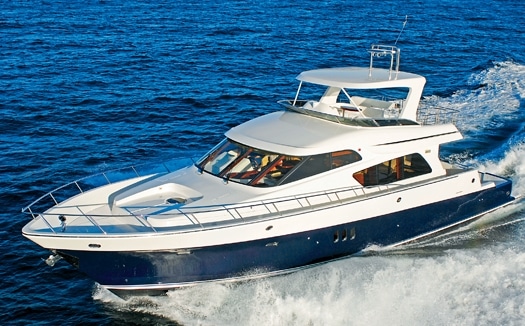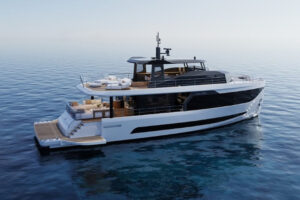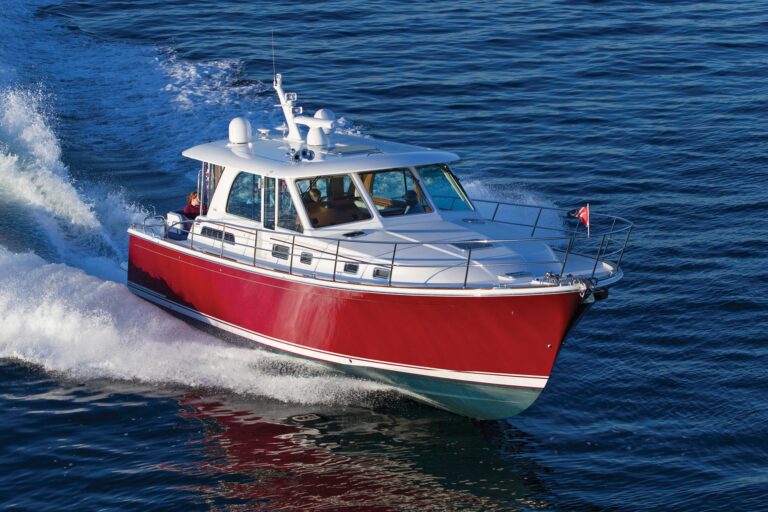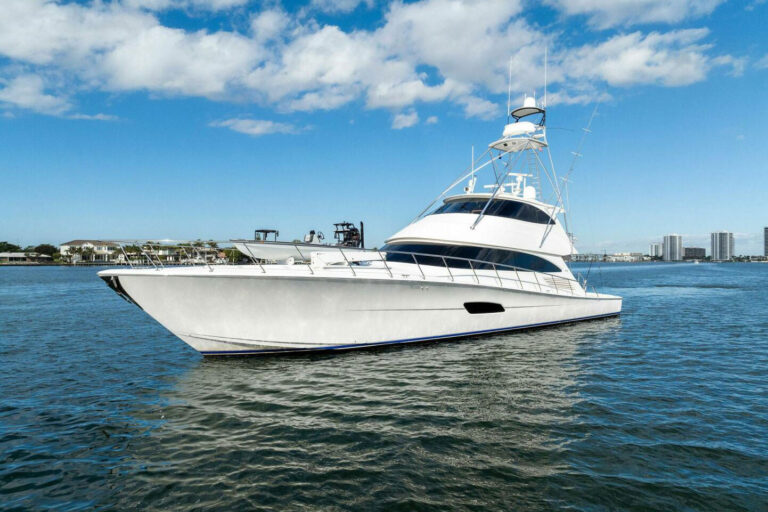
mckinna69445.jpg
There are two ways to look at the new McKinna 69 Series Pilothouse Motoryacht: as a really large 69-footer and as a really large 60-footer. If that sounds contradictory, it’s really not.
That’s because both the 60 Series and the 69 Series start with the same hull. Designed by Howard Apollonio to work equally well as both a 60-footer and a 69-footer, the only real difference between the two boats is the addition of a 9-foot cockpit extension.
The 69 Series Pilothouse that you see on these pages is really a “stretch” version of McKinna’s 60-footer, which is available in an open bridge, hardtop, and skylounge version. Those same options apply to the 69-footer, so you can mix or match your arrangement to fit your needs. No matter how you cut it, this new yacht provides a remarkable amount of interior room, regardless of the length.
Unless I were forced to stay with a 60-footer because of docking constraints, I’d opt for the longer McKinna just because she gives you so much for a relatively small cost increase. That 145 square-foot cockpit allows you to install a fighting chair if you want to do some offshore fishing, and it provides a “beach” area for swimming, snorkeling, or diving. It makes access to and from the tender easier, and it provides a secure access to the engineroom even when you’re offshore. You can even add a swim platform or a tender lift to carry the tender aft.

| | |
Once you go up the wide curving stairway from the cockpit, however, you have the same spacious luxury as the McKinna 60. While the McKinna hull is from Howard Apollonio, the interior and styling is by Juan Carlos Espinosa, who made the most of the 18-foot, 7-inch beam (wider than many boats in this class) to create a spacious saloon that still allows for comfortably sized walk-around side decks.
If ordered as a 69-footer, the raised afterdeck becomes a California deck overlooking the cockpit, and serves as a transition area between saloon and cockpit. There is a settee on one side, wide steps to the flying bridge, plus room for a barbecue-although that’s better placed on the bridge.
In a thoughtful break with tradition, McKinna has placed a day head to starboard, with direct access to the after deck and the cockpit. It’s a design feature that is so useful I’ll be surprised if more builders don’t seize upon the idea. Besides, it takes advantage of an otherwise wasted corner of the saloon (how many china cabinets do you really need?).
The interior of this particular McKinna, from East Coast dealer Generation Marine of Ft. Lauderdale, was finished in a pleasant African cherry for the look of a men’s club, but American cherry, anigre, and teak are also available. The saloon is designed for entertaining and as a media room, with an L-shaped settee to port, a pair of barrel chairs opposite, and a pop-up television in the cabinetry. Should you want to use the saloon for meals, the coffee table cranks up to dining height.
Of particular note are the large windows, which provide a great view even when seated, and contribute to the general airiness of the saloon. I also liked the pull-out trays, like those in professional sound studios that provide access to the entertainment components.
Adding to the feeling of space is the absence of a pilothouse bulkhead, so the entire main deck is open from the cockpit sliding doors to the pilothouse windows. Up two steps is the pilothouse level, which has the galley, another built-in settee with table, and, of course, the helm.
Granite counters are standard in the galley, as are the four undercounter U-Line refrigerator/freezer drawers and the teak-and-holly sole for easy cleaning. There’s a drawer-style dishwasher and ample cabinets, including overhead lockers for food and cookware.

| | |
Anyone who plans to cruise short-handed will appreciate the pantograph pilothouse door that allows direct access to the side and foredecks. The skipper is also provided with a hand-held third station control so he can move around on deck while docking or anchoring.
Another unique feature of the McKinna 69 Pilothouse is that the owner’s suite, located amidships for minimum motion, has a private entry from the saloon. You don’t usually see this in yachts of this size, and even larger yachts often save space by making one stairway serve both guest and master cabins.
I like the privacy afforded by the separate entry, especially in a yacht where the guest cabins share a single head forward. That layout always results in a certain amount of door-banging early in the morning. No owner, on departing his own stateroom, wants to encounter a guest with a toothbrush- filled mouth in the hallway.
The master suite uses the wide beam to advantage, placing the head on the starboard side, a vanity/desk to port, and a centerline berth facing aft. The large master head has a marble countertop and sole, with an oversize shower and Grohe fixtures. The VIP stateroom is forward, with a queen-size berth and built-in lockers and drawers. There is direct access to the head without leaving the cabin, and the spacious marble-lined head has a shower.
A convertible guest stateroom is to port, with both a lower double and upper single berth for kids, or the area can be arranged as an office with a single berth. The guest foyer also has a hidden stacked washer/ dryer for extended family cruises.
Aside from the cockpit decision, the bridge area offers the most owner choices on the McKinna 69. In the simplest (and least expensive) form, the open bridge is the base point but, in today’s sunburn-wary world, every owner will want to add a canvas Bimini top for protection.
Considering the cost of such a Bimini, which will also need replacement in the future, it’s a no-brainer to opt for the fiberglass hardtop. Some companies get by with makeshift hardtops, but McKinna isn’t one of them. The McKinna hardtop is a stylish extension from the radar arch, and it’s beautifully finished underneath with lights and speakers. It also makes a full enclosure an inviting option, which creates an allseason bridge capable of use in rain and tropic sun, cold, or heat.
The fully enclosed Skylounge is a third option, which gives you a more durable bridge with sliding windows and an after door. I would suspect that McKinna will sell a number of Skylounges to people who first talk themselves from the open bridge to the hardtop, then to the hardtop enclosure and, finally thinking “might as well,” into the Skylounge.
Whatever the enclosure choice, the bridge layout remains basically the same, with a fiberglass centerline helm console that duplicates the lower helm (in this case, with a Raymarine E-120 screen) and a doublewide helm seat. Just aft to starboard is a wraparound lounge seat with table and a settee is to port opposite the helm.
Back on deck, the wide beam makes for side decks that are comfortably sized and, with high bulwarks capped by stainless steel rails, secure in a seaway. I haven’t seen the McKinna by night but, judging by the number of LED lights scattered around the decks and walkways, it would be extremely well illuminated.
Forward, there is the ubiquitous sunpad on the foredeck, this time with an iPod docking station for private music. The anchor windlass is tucked under the deck so the foredeck is kept clear, and there are oversize cleats with properly placed hawse pipes.
Access to the engineroom is through a watertight pantograph door off the cockpit. A compartment on the port side is an engineering and electrical flat, with the batteries, stacked 4 kW inverters, isolation transformers, and room for added gear that might not like the heat of the engineroom.
Another watertight door leads to the engineroom, where there is an astounding 6 feet, 8 inches of headroom as well as plenty of room to get around the twin 1,000-hp Caterpillar C18 diesels. With molded non-slip flooring, this is a service technician’s dream come true.
It’s also where you’ll see how thoughtfully and completely the Mc-Kinna has been equipped as a standard yacht, not just in the plasma TVs and galley appliances, but in the gear that is really important-the Wesmar bow thruster and stabilizers, the five-zone air conditioning, and the twin generators. The McKinna is delivered with a 21.5 kW Onan generator in a sound shield plus a night-use genset, an Onan 9 kW, also in a sound shield.
Construction on the McKinna uses well-proven technology with a solid fiberglass hull of vinylester resin for blister protection, Core-Cell reinforcing rather than wood or balsa, and Kevlar, which is used in high-load areas such as window frames throughout the yacht.

| | |
We didn’t get a chance to measure the range of speeds because of a dinged prop that would have skewed the results but, with the props in tune, this McKinna 69 topped 23 knots with full fuel and nine people aboard.
Whether you call it a big 60-footer or a big 69-footer, it’s likely that you’ll be impressed by the styling and the construction of the new McKinna 69 Series Pilothouse Motoryacht.
Contact: (954) 321-1457; www.generationmarine.com; www.mckinnayachts.com.








